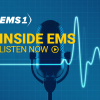This episode of Inside EMS is brought to you by Lexipol, the experts in policy, training, wellness support and grants assistance for first responders and government leaders. To learn more, visit
Click here to watch a video of this weekŌĆÖs episode!
In this episode, Chris and Kelly discuss the recent spotlight on public access defibrillation after high profile cardiac arrests in young athletes, as well as the growing danger of assaults in the field for EMTs.
Together, they discuss:
- Bronny James, USC freshman and son of Lakers star LeBron James, was resuscitated after a cardiac arrest at USC basketball workout
- Julia Taylor Fatum, a N.Y. EMT, was stabbed and nearly killed by a patient in her ambulance
- The death of Lt. Alison Russo-Elling, who was stabbed multiple times
- The collapse of Damar Hamlin and the world watching his on-field resuscitation
- Has EMS taken a step backwards in training the public?
- How violence against providers is becoming a retention issue
Memorable quotes
ŌĆ£Children and athletes and young adults can go into cardiac arrest, and I would wager that the only thing that saved Bronny JamesŌĆÖs life is that second link in the AHA chain of survival, which is prompt, early access to defibrillation, and itŌĆÖs a shame that public access to defibrillation in so many places is still a pipe dream or poorly implemented such that itŌĆÖs not really public access.ŌĆØ ŌĆö Kelly Grayson
ŌĆ£Public access to defibrillation means just that: public access to defibrillation. ItŌĆÖs not a special thing for special people to use. The whole point of public access to defibrillation is that it can be readily accessed by anyone.ŌĆØ ŌĆö Kelly Grayson
ŌĆ£As an EMS leader ŌĆ” that has to be first and foremost concern of mine: to make sure that the workforce goes home at the end of their shift. And IŌĆÖm losing faith in that we are keeping our providers safe.ŌĆØ ŌĆö Chris Cebollero
ŌĆ£WeŌĆÖve been on calls that have been very benign, that have escalated verbally, that have escalated behaviorally.ŌĆØ ŌĆö Kelly Grayson
ŌĆ£Keep your heads on a swivel. Always be alert, always have your eye on your patient.ŌĆØ ŌĆö Kelly Grayson



